Rebounding offers seniors exceptional health benefits in a gentle, joint-friendly format. You’ll strengthen bones without harsh impact, improve balance to prevent falls, and boost cardiovascular health with less exertion than running. This fun exercise enhances core stability, lifts mood through endorphin release, builds functional strength for daily tasks, and stimulates your metabolism for better energy levels. Discover how this simple activity can transform your senior fitness journey with just minutes a day.
7 Best Rebounding Benefits For Active Seniors
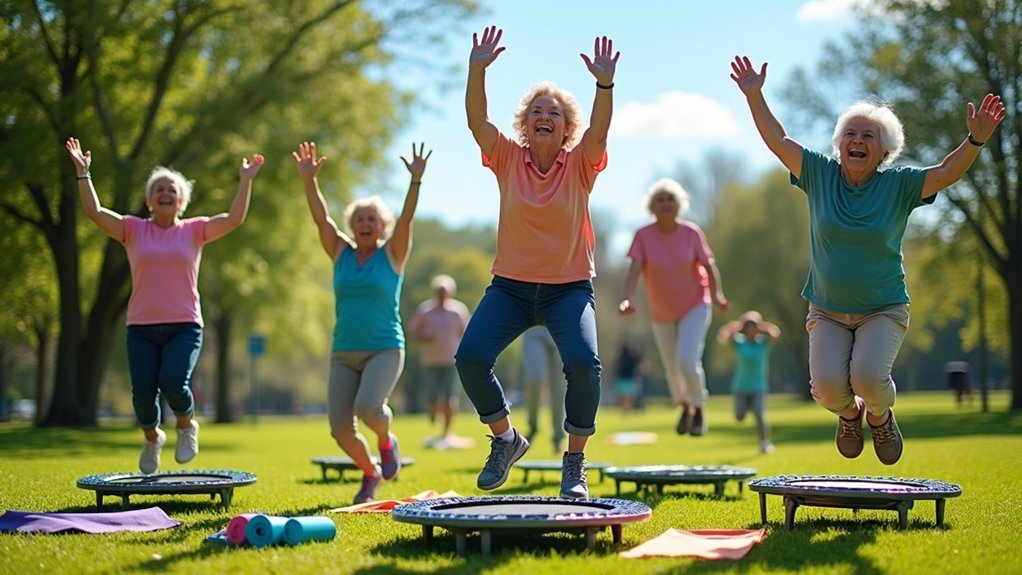
While many exercise options exist for older adults, rebounding stands out as an exceptional choice that combines gentle impact with remarkable health benefits.
You’ll experience improved bone density through controlled impact that stimulates bone strengthening without the high joint strain of other activities.
Your cardiovascular system benefits with 20-30% lower metabolic cost than running, making workouts more sustainable.
The gentle bounce of rebounding gives your heart the workout it needs while demanding less energy than pounding the pavement.
Rebounding enhances your cognitive function by increasing cerebral blood flow, supporting memory and concentration.
You’ll build lower-body strength in your quadriceps and glutes while improving balance through core activation. The gentle bouncing motion helps release endorphins naturally, improving your mood and reducing stress levels.
Perhaps most importantly, rebounding reduces your fear of falling while promoting social engagement in group classes.
The 16-week programs show measurable strength gains, helping you maintain independence and enhance your quality of life.
Strengthening Balance to Prevent Falls
Your mini-trampoline workouts train controlled landings that directly translate to more stable movements in daily life.
The gentle bouncing motion engages your core muscles, creating a stronger foundation that helps you maintain equilibrium when faced with unexpected balance challenges.
As you rebound, your body constantly adjusts to the changing surface, sharpening your proprioceptive awareness—the internal sense that tells your brain where your body is in space.
Studies show that just 14 weeks of consistent mini-trampoline exercises can improve your balance by 35 percent, significantly reducing fall risk for seniors.
Training Controlled Landings
Three crucial elements make controlled landing training essential for active seniors looking to prevent falls.
First, it enhances your neuromuscular control—the coordination between muscles and nerves during movement.
Second, it builds lower-limb strength, particularly in quadriceps and calves that absorb impact.
Third, it sharpens proprioception, your body’s awareness in space.
Begin with base stability exercises like tandem stance drills before progressing to single-leg holds.
You’ll benefit from introducing sensory challenges gradually, such as standing on softer surfaces.
Always prioritize safety by using chairs for support when needed and wearing flat, cushioned shoes for ideal ground feedback.
Research confirms these techniques considerably improve postural balance, functional mobility, and quality of life while reducing fall risk—all with minimal equipment required.
Consulting with a healthcare provider before starting new exercises ensures your training program addresses your specific balance needs and limitations.
Building Core Stability
A strong core serves as the foundation for all movement in active seniors, connecting your upper and lower body while stabilizing your spine during daily activities.
When rebounding, your core muscles constantly engage to maintain balance on the unstable surface, creating an ideal training environment for fall prevention. Regular rebounding sessions can help reduce fall risk significantly, as statistics show falls occur every 12 seconds among older adults.
To maximize core stability on your rebounder:
- Practice seated abdominal curls to engage your transverse abdominis before progressing to standing bounces, building the trunk stability needed for proper rebounding form.
- Incorporate modified planks by placing your hands on the rebounder’s frame while keeping feet on the floor, strengthening deep core muscles without high-impact stress.
- Try standing weight shifts on the rebounder’s surface, teaching your body controlled center-of-mass adjustments that translate directly to improved balance during everyday movements.
Improving Proprioceptive Awareness
While many seniors focus solely on strength training, proprioceptive awareness—your body’s ability to sense its position in space—plays an essential role in preventing falls.
Rebounding exercises naturally enhance this awareness as you adjust to the mini-trampoline’s unstable surface.
Try standing on one leg while on your rebounder, or practice heel-to-toe walking across its surface. These challenges strengthen your body’s position sense without visual cues.
For maximum benefit, incorporate dynamic movements that mimic real-life situations. Maintaining good proprioceptive awareness helps improve balance, reaction time, coordination, and agility in your daily activities.
Regular proprioceptive training on a rebounder helps you recover quickly from minor balance disruptions and adapt to changing environments like uneven sidewalks.
This sustained practice not only reduces fall risk but also maintains your independence and mobility, allowing you to navigate daily activities with confidence.
Building Bone Density Without Joint Strain
You can strengthen your bones through rebounding’s gentle impact that stimulates osteogenic activity without harmful joint compression.
The trampoline’s surface absorbs up to 87% of landing forces, creating just enough mechanical stress to encourage bone adaptation while protecting sensitive joints.
Though studies show modest BMD improvements, rebounding’s combination of low-impact loading and balance challenges makes it especially valuable for seniors managing osteopenia or arthritis concerns. However, a 2023 study of postmenopausal women did not establish definitive proof that rebounding effectively builds bone density.
Impact Without Compression
For seniors concerned about bone health, the dilemma often seems impossible to resolve: impact exercises build bone density, but they can damage aging joints.
Rebounding offers a unique solution through “impact without compression” – your body experiences gravitational changes that stimulate bone growth without the harsh impact that typically stresses your joints.
This remarkable mechanism works because:
- The trampoline surface absorbs up to 87% of impact force that would otherwise travel through your ankles, knees, and hips.
- Your cells experience beneficial G-force variations that trigger bone-building processes without joint strain.
- The even distribution of impact throughout your body promotes thorough bone remodeling without concentrating stress on vulnerable areas.
Since osteoporosis occurs when new bone creation lags behind old bone removal, rebounding helps maintain this crucial balance.
You’ll strengthen your skeletal system while protecting your joints – truly the best of both worlds.
Gentle Osteogenic Loading
Bone density naturally declines as we age, creating a critical challenge for seniors who want to stay active without risking injury.
Rebounding offers an ideal solution through gentle osteogenic loading—a process that stimulates bone growth without stressing your joints.
When you bounce on a rebounder, you’ll experience brief moments of increased gravitational force that trigger bone strengthening responses. This low-impact activity applies controlled stress to your skeletal system, enhancing bone density where you need it most.
Unlike high-impact exercises that can damage aging joints, rebounding creates the perfect balance of bone stimulation without compression.
You’ll benefit from improved bone mineral density and reduced fracture risk while maintaining proper alignment. Research shows that brief, low-impact osteogenic exercises can significantly improve bone mineral density in postmenopausal women with osteoporosis. For best results, start with short sessions and gradually increase duration as your body adapts to this gentle yet effective form of exercise.
Maximizing Heart Health With Low-Impact Cardio
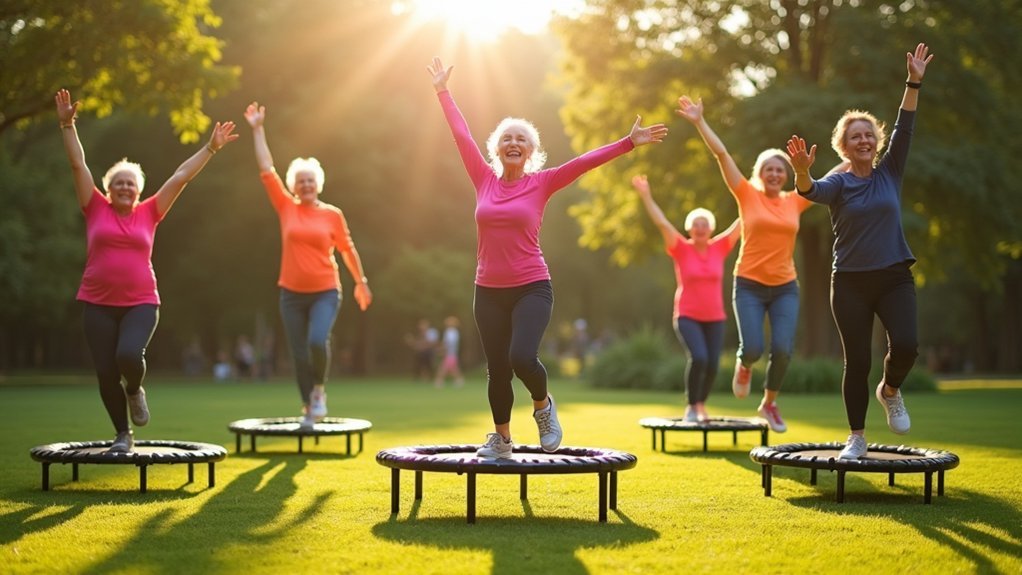
Energy in our golden years depends considerably on maintaining cardiovascular wellness, making low-impact cardio exercises essential for seniors. Rebounding offers an ideal way to strengthen your heart without stressing your joints. The American Heart Association recommends 30-60 minutes of exercise 3-4 times weekly at 50-80% of your maximal heart rate.
- Consistent rebounding improves circulation, lowers blood pressure, and enhances heart function—all crucial for maintaining independence.
- Gentle bouncing movements strengthen your heart muscle while improving lung capacity, giving you more energy for daily activities. These exercises are particularly beneficial as they minimize joint strain while providing effective cardiovascular workouts.
- Gradual progression in your rebounding routine builds endurance safely, helping you maintain muscle mass and reduce fall risks.
Start slowly and remain consistent to maximize these cardiovascular benefits for long-term health.
Developing Functional Strength for Daily Activities
Beyond heart health, functional strength determines how well you’ll handle everyday tasks as you age. Rebounding exercises help you build this practical strength by engaging multiple muscle groups simultaneously.
Regular rebounding mimics the movements you need for daily living—the gentle bouncing strengthens your legs similar to squats, improving your ability to get in and out of chairs.
Rebounding builds practical leg strength that directly supports your ability to maintain independence in everyday movements.
The stabilizing movements on the trampoline enhance core strength, which supports balance and reduces fall risk. Research has shown that functional fitness activities significantly improve muscle strength and mobility in older adults.
As you rebound, you’ll naturally perform twists and rotational movements that maintain flexibility in your torso. This translates directly to easier movement when turning or reaching.
The constant adjustment required while bouncing also improves coordination, complementing other balance exercises like tai chi or single-leg stands.
Enhancing Mental Wellbeing Through Rhythmic Movement
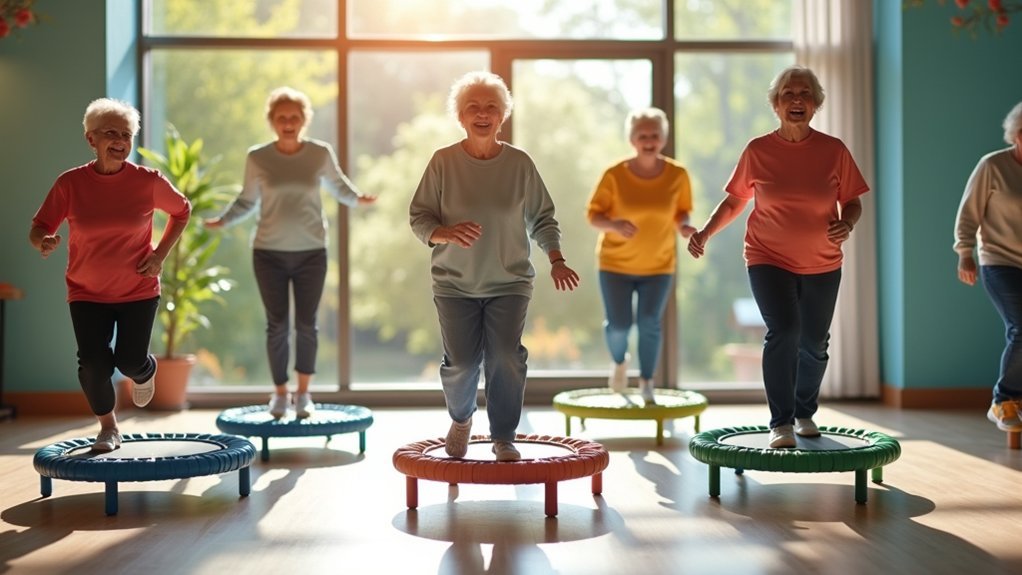
The rhythmic bouncing motion of rebounding offers remarkable mental health benefits alongside its physical advantages. When you bounce on a mini-trampoline, your brain releases endorphins that can greatly reduce symptoms of depression and anxiety while enhancing your emotional resilience.
The gentle, repetitive movement creates a meditative state that helps clear your mind of daily worries. Similar to dance therapy, rebounding can help maintain cognitive function in healthy older adults through its combination of coordination and mental engagement.
- Mood Enhancement – The consistent rhythm of rebounding triggers endorphin release, creating natural feelings of joy and reducing stress hormones
- Social Connection – Joining group rebounding classes combats isolation and builds community through shared activity
- Cognitive Stimulation – The coordination required engages multiple brain regions, potentially improving mental clarity and focus as you age
Boosting Metabolism and Energy Production
While aging naturally slows down metabolic processes, rebounding offers a powerful counterbalance for seniors seeking to maintain their energy levels and metabolic health. This gentle bouncing activity enhances mitochondrial efficiency, optimizing ATP production at the cellular level without taxing your joints.
NASA research confirms rebounding achieves cardiovascular benefits with lower metabolic cost than running. You’ll burn calories efficiently while activating core and lower body muscles simultaneously. Studies show that 10 minutes of rebounding delivers the same benefits as 30 minutes of traditional running, making it ideal for seniors with limited stamina.
The rhythmic motion also stimulates lymphatic flow, removing metabolic waste and reducing inflammation linked to energy depletion.
Regular rebounding preserves lean muscle mass essential for maintaining your resting metabolic rate and combats age-related sarcopenia.
You’ll also experience improved insulin sensitivity, enhanced glucose metabolism, and better sleep quality—all contributing to sustained energy levels throughout your daily activities.
Frequently Asked Questions
How Long Does a Mini-Trampoline Typically Last With Regular Use?
With regular use, your mini-trampoline typically lasts 3-8 years. You’ll get longer life when you choose high-quality materials, perform routine maintenance, and store it properly. Individual components may need earlier replacement.
Can Rebounding Be Effective for Seniors With Hip Replacements?
Yes, you can benefit from rebounding after hip replacement with proper clearance from your doctor. Start with modified, low-impact bounces using handrails for stability. It’ll improve balance and strengthen muscles around your implant.
What Safety Features Should Seniors Look for in a Rebounder?
Look for rebounders with sturdy safety handlebars, non-slip feet, spring/bungee covers, and appropriate weight capacity. You’ll also want anti-slip mats and a stable frame. Don’t forget adjustable features for your specific needs.
How Does Rebounding Compare to Water Aerobics for Joint Health?
Rebounding offers controlled impact that stimulates bone health while reducing joint strain, whereas water aerobics eliminates impact entirely through buoyancy. You’ll find both beneficial, but rebounding maintains some weight-bearing benefits water exercise doesn’t provide.
Can Medication Timing Affect Performance or Benefits of Rebounding Exercise?
Yes, your medication timing can affect rebounding performance. Some drugs absorb faster post-exercise, while others may influence energy levels or balance. You’ll want to consult your healthcare provider for personalized advice.
In Summary
You’ll find rebounding offers a perfect fitness solution for your active golden years. It’s gentle on your joints while strengthening your balance, bones, and heart. Just a few minutes daily builds functional strength, boosts your mood, and revs up your metabolism. Whether you’re a fitness enthusiast or just starting out, this low-impact exercise delivers impressive health rewards that’ll help you maintain your independence and vigor.
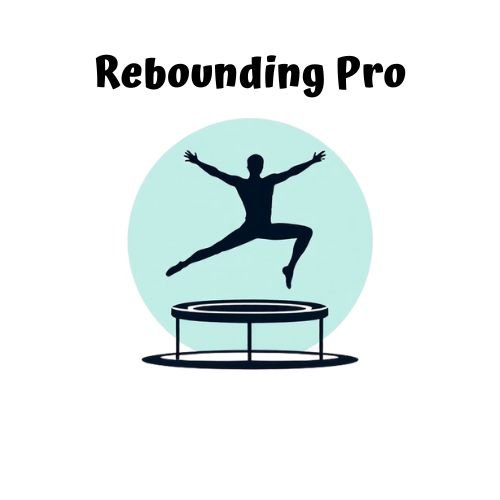
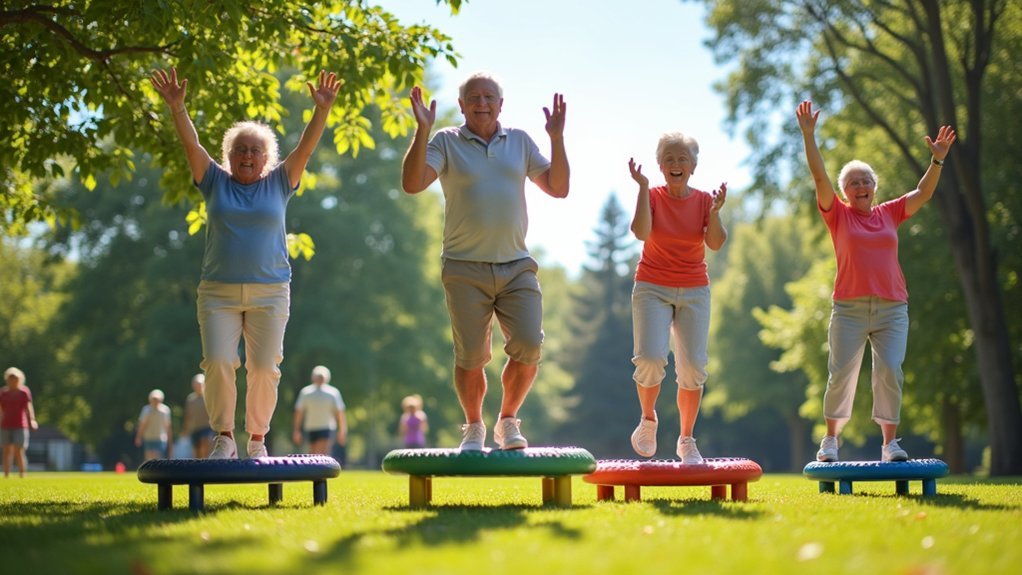


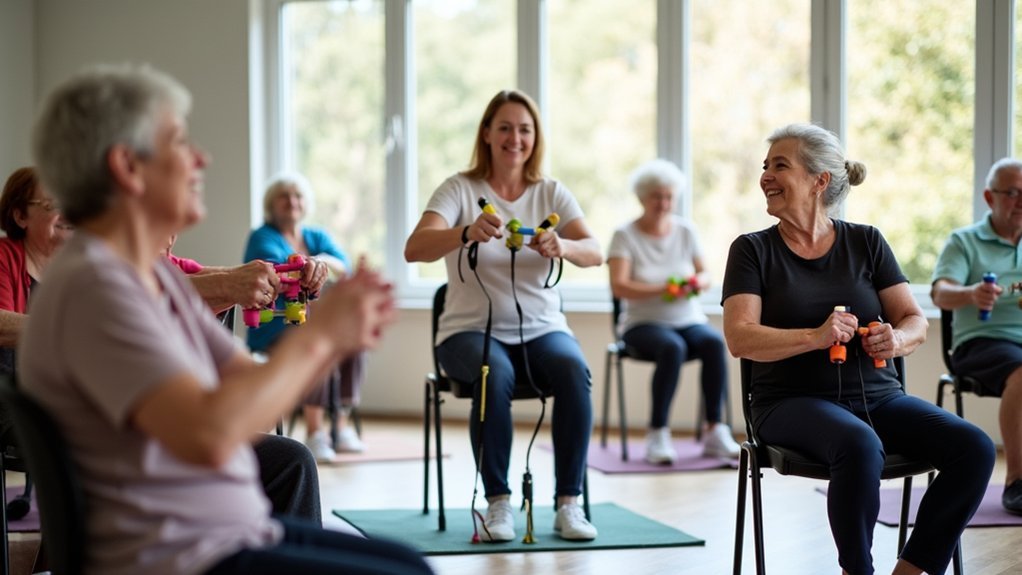
Leave a Reply